

A visit was made to Three Rivers in January 1980 by Rob Witty of RAL and Robert Rae of Edinburgh University to assess the current state of the PERQ. Through the connection with Dr Thomas of ERCC, the Edinburgh AI community had become aware of the PERQ' s potential. Robert Rae was funded by ICF on the SIGAI contract with Dr Howe's AI Department in Edinburgh.
The purpose of the visit was to establish the true state of production progress of the PERQ and to assess the PERQ hardware and software. The main people involved in the PERQ hardware design were:
At that time, Paul Newbury was President of the company although Ed Fredkin was giving commercial advice and beginning to exert his influence on the company.
The main interface to SERC at that time was Bob Spuntak who had joined in October and was head of marketing and sales.
On arrival at Three Rivers, Rae and Witty found that the production of systems was nowhere near as advanced as the information being obtained via telephone implied.
The prototype wire-wrapped version shown at SIGGRAPH 79 had demonstrated the feasibility of the design and the work since August had been aimed at producing production systems based on the prototype. There are three boards in the machine (processor, memory and I/O) and a major activity was getting PCB versions of the boards designed and produced. The other major activities were producing the cabinet into which the boards were fitted and the associated monitor. This is an over-simplification but is sufficient to describe the state.
Witty was told that five systems had been assembled apart from the three boards and these were tested out using the existing wire wrap boards. Only two of the five systems were around at Three Rivers and, apparently, the other three systems had already been shipped without PCB versions of the board. The PCB boards would be sent to these systems as soon as they arrived. SERC had no evidence that those three systems had been built and shipped. For example, CMU, the most likely customer, did not have the systems. It is possible that they went to undisclosed customers (IBM, US Government?) but RAL was sceptical. The destinations were quoted as Los Angeles, San Francisco and New York.
At this stage of production, nearly all the hardware was in good shape apart from the boards. The price of Winchester discs had dropped since August so that Three Rivers were planning to ship 24 Mbyte Winchester discs in place of the original 12 Mbyte one. Work on the 50Hz power supply was not high priority. Consequently the intention was to ship 60 cycle versions with a 50Hz conversion kit to be supplied later.
The monitor was impressive with clarity and resolution much better than anything on the market. The machine generated a reasonable amount of noise but was quieter than the Alto which had been used in office environments within Xerox for a number of years. It had passed the USA UL (Underwriters Lab) safety requirement tests but work was needed before the German VDE specification would be met.
The aim was to ship a system to RAL near the end of January without PCB boards with the missing PCB boards to be shipped about 5 weeks later. ICL needed to make a decision whether to leave their system at Three Rivers and allow their maintenance engineer, who was attending the Three Rivers course, to commission the complete ICL machine at Three Rivers as a method of increasing his ability to maintain future systems.
The major problem was the three boards and in particular the processor board. Summagraphics had been subcontracted the job of doing the PCB layout of this board (290 chips on a 6 layer board) and had failed to do the job. Incidentally, some of the problems with VAX 11/780 deliveries were due to the same cause. A new design based on 8-1ayers was due to arrive near the end of February. Progress was almost stopped apart from building systems due to the lack of processor boards.
The memory board was complete and Three Rivers had 25 in stock ready for the first batch of systems.
The I/O board was in a half-way stage. Some boards were available in a multi-wire construction (wires glued like PCB tracks) and these could be used in the early systems. Debugging of the board was held up by the non-appearance of the processor board. To ease their cash flow problems, the company had held off buying components for more boards until the processor boards arrived.
It now seemed unlikely that the SERC system would be available earlier than April on an optimistic timescale and could be later. Unless Three Rivers generated some revenue in the near future, it had insufficient money to last out its current financial problems. This was particularly true as the original aggressive pricing of the product did not leave a large surplus per system shipped.
Within Three Rivers, a power struggle appeared to be developing between Brian Rosen and the original developers of the system and Ed Fredkin and the recently acquired financers who wished to see some return on their investment.
In retrospect, many of the optimistic claims coming out of Three Rivers were clearly aimed at getting systems shipped without boards and, as a result, getting some part of the purchase price paid. Also, there was a real need to clinch a deal with ICL based on ICL putting up capital in return for marketing rights.
The PERQ is a soft machine with the writeable control store being used to define the order code. The PERQ software had been designed on the basis that the order code would be such as to make the execution of PASCAL programs efficient. Consequently, the order code was very similar to the PASCAL P-codes used as an intermediate language by the portable PASCAL compilers. This philosophy is similar to the early IBM machines which can be thought of as FORTRAN machines, the Burroughs systems as Algol machines and more recently the ICL 2900 architecture which is very much Algol 68 based.
The major constraint in the initial order code implementation was the lack of a virtual memory capability. The motivation was that it was probably unnecessary initially, it could be simulated by additions to the microcode and when fully understood, hardware changes would be made to incorporate the virtual memory functionality in the hardware. There was also only a 20-bit physical address space.
There was some evidence even at this stage that the machine was basically a hardware driven product and there was some reluctance to include paging rather than segmentation in the hardware because of the likely degradation in performance. Paging was seen, therefore, as a necessary evil that would need to be added at some stage rather than a central design concept.
Three Rivers had developed a basic operating system (POS) for the PERQ and a pre-release version would be available on initial delivery. It effectively provided a good environment for editing, compiling and running PASCAL programs one at a time with a tree-structured file system. There was good evidence that the PASCAL compiler and its environment worked well. Progress in this area was not hindered by unavailability of hardware as most of the development work was taking place on three PDP11s which simulated the end environment.
The editor under development used the PERQ screen effectively and would be a definite advantage. Further developments of a high quality editor were underway at CMU.
Plans existed for a window manager and the overall architecture had been defined although implementation had not started.
The general view was that the software was sufficiently good that PERQs could be used effectively on arrival but that there was a need to improve the sophistication and functionality of the operating system before the full potential of the system could be realised.
Three Rivers had signed an agreement with GE to provide PERQ maintenance if there was a demand. The one-off price quoted was $294 per month. GE were prepared to do this in places world-wide probably based on major urban centres. The availability of maintenance via this route in the UK would depend on negotiations with ICL.
Contact was also made with CMU on the January visit to Three Rivers. The major interest from CMU was the SPICE project which was looking for a very high-powered low-cost single user workstation to be used as a vehicle for an integrated distributed environment for CMU. The two main people involved at that stage were Bob Sproull and Peter Hibbard (an Englishman).
The SPICE project had put out an Operational Requirement to industry in general and had no success in identifying a system that met their requirements. The PERQ came closest to their needs but fell short due to lack of virtual memory, the relevant software environment etc. As a result, the SPICE project had decided to build a portable distributed operating system environment which could be implemented over a range of hardware. There was a fundamental requirement for virtual memory. As a result, the initial plan was to purchase PERQ systems and to change the microcode to provide a different but similar environment to the standard PERQ one which would have a message-based kernel, virtual memory etc.
One result of the SPICE announcement was the decision by DEC to produce a single board VAX rather than continue development of the 36-bit DEC10/20 range.
At that time, CMU had about 12 Altos which Xerox had given them and were expecting a further 17. These were significantly lower in performance, disc capacity and display quality than the PERQ but would be used as prototype development vehicles.
Peter Hibbard estimated that CMU would have about 10 PERQs by the end of the year for SPICE developments. They had a contract with Three Rivers to provide a sophisticated editor.
Robert Rae visited a number of other sites on the January visit to the USA. At that time, VAX computers were beginning to get installed in the research community with the tendency to move from AT&T UNIX to Berkeley UNIX to improve performance. Even so, Berkeley UNIX was then running at about 20% the performance of VAX VMS.
Motorola were beginning to give presentations on their new MC68000 microprocessor but it was still not possible to get chips.
At MIT, LISP machines were being run in the AI community. MIT were considering whether to go into production at a cost of $80K per system. Also, at MIT, the Nu machine was under development. This was aimed at supporting either the new Motorola 68000 or the Zilog Z8001. The aim was to have a working prototype by the end of 1980.
Discussions were had with BBN and Prime concerning the production of a marketable INTERLISP machine. The lack of a dual ported memory on the PRIME and the need to have PRIMOS between INTERLISP and the hardware meant that BBN were beginning to feel that this was not the correct approach. As a result, BBN were considering the production of a single user workstation using the PRIME virtual memory system as a basis. This machine, called Jericho, would be a 3-board machine using bit-slice technology.
The main conclusions from the trip were that there appeared to be nothing comparable to the PERQ that is either commercially available now or likely so in the near future. Other projects did exist. The only ones in any real state of development were Xerox (although it was clear these would not be marketed), BBN (but using their own funds and could well be abandoned), MIT (no clear decision whether they would market and almost certainly aimed just at the AI market) and Apple. Rumours were beginning to circulate of a major product under development (later turned out to be the LISA). There were laboratory projects at IBM, Digital, Hewlett Packard and Tektronix but all were a long way from production.
The first big PERQ Product Announcement for PERQ came in the Spring edition of Lambda. It quoted a basic price of £19,500 per system with deliveries available in December. As a result of this and the general grapevine, tentative orders had come in from ISI, CMU, Interactive Systems Group, Logica, US Navy, CIA, IBM, Amdahl, Bell Labs, DEC, Phillips, Olivetti, ICL etc. Three Rivers clearly had a product that was wanted if they could deliver it.
A subsequent visit by ICL to Three Rivers in February urged the company to give more realistic dates for the UK deliveries. By now, Fredkin was having some influence on the company and he echoed these feelings.
There had been further slippage on the processor board and the mask for the Board was not expected to arrive until March. It was agreed that initial shipments should be made in the Pittsburgh area allowing 4 weeks at least for quality assurance and testing. As a result, the delivery timescales were put back to June 1 for the first two systems with 3 more systems being delivered from the second production batch in August. It was anticipated that the company would be shipping 10 per month by August and 30 per month by the end of the year.
Interactive Systems Incorporated of Santa Monica (who may have already got a partial system) had agreed to mount UNIX on the PERQ and were committed to releasing it 60 days after receiving a complete system.
By mid February, Three Rivers had received orders for 50 systems from 17 different customers. The works cost of $12K on a system being sold at around $20K was clearly underpriced and Three Rivers planned a price review. It was clear that the market response was driven by the quality of the product and not the price.
In March, the mask for the processor board finally arrived and a batch of processor boards were produced and populated only to find problems on the board. As a result changes had to be made and a new batch commissioned. The June delivery date was still feasible but unlikely. The Three Rivers salesman, Bob Spuntak, was still giving RAL his personal assurance of early delivery but all faith had been lost in his telephone calls and the only way to estimate progress was by visits to Three Rivers.
The next set of boards proved to be satisfactory although more time was taken sorting out minor problems than was anticipated, particularly in the I/O system which had been sitting waiting for the processor board. As a result, there were some unaesthetic but workable changes made to the I/O board.
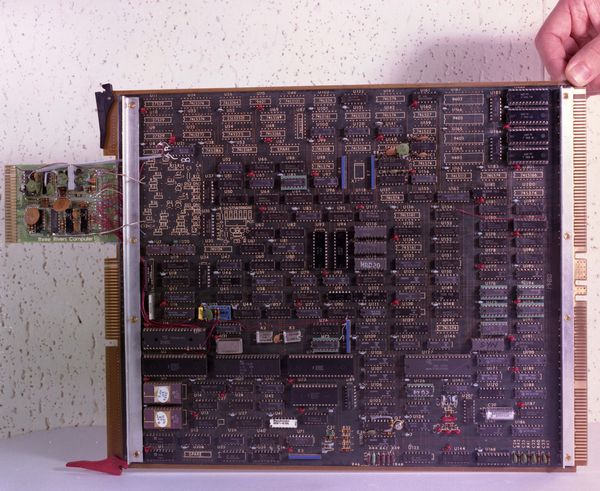
This effectively meant a slippage on the UK systems past the summer. Also Three Rivers diverted a great deal of effort towards an effective launch of the PERQ with software at the SIGGRAPH meeting in July. They were now attempting to raise money due to their cash flow problems and a successful launch of a production system at SIGGRAPH would be the way to ensure this funding.
In May 1980, Bill Poduska left PRIME with a number of colleagues to form a company marketing high powered personal computer systems. This soon was known as the Apollo project and there was great interest in what they might come up with.
A graduate student from Stanford had also set up a small company to produce a processor board which also included fast Rasterop hardware.
SIGGRAPH in Seattle in July had a large trade show with Three Rivers as the most attractive and most frequented stand. Two complete systems were up and running demonstrations. One was a prototype with wire wrap boards while the other had a complete set of PCB boards with both the processor and I/O boards having a number of wiring connections. The company now had 25 sets of PCB boards and shipments would start soon after the return from SIGGRAPH. Effectively, all the main PERQ people were at SIGGRAPH.
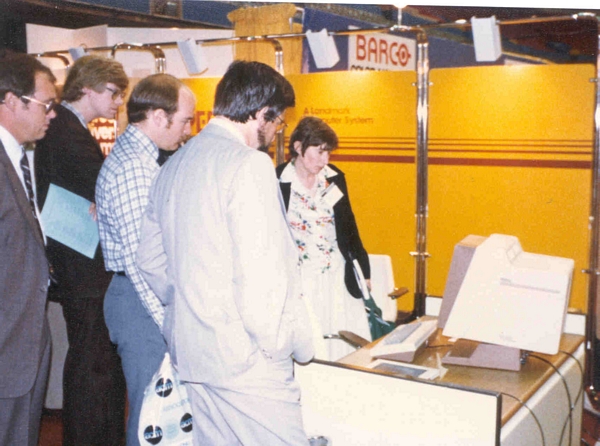
The systems worked in a rather hot environment for 3 days with almost no faults. A disc controller fault took them most of one evening to cure and there were some hardware glitches which caused them to occasionally reload the system.
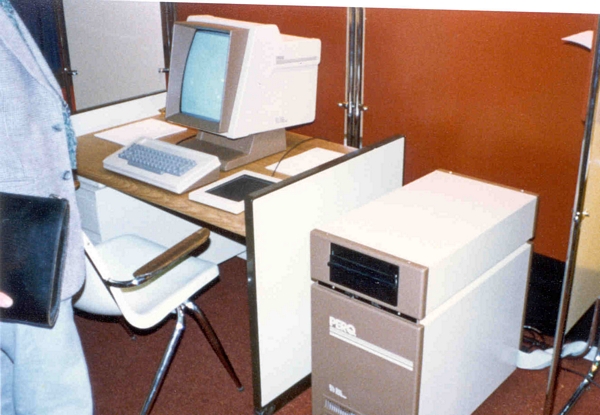
The demonstrations were most impressive including one involving a window manager with animated displays in the windows and showing graphics performance significantly better than anything other than high cost top-end graphics systems in the show.
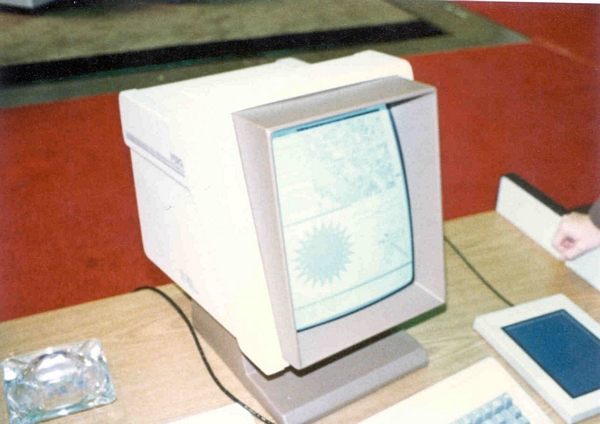
Three Rivers still had a clear lead in hardware terms over its competitors. There had been progress on the software side but Three Rivers were still only considering a simple POS operating system although software virtual memory was envisaged in the next release of the software.
Deliveries of PERQ started to CMU on August 20. The first system ran as soon as it was plugged in and continued to run without a fault for several months. A second system was delivered soon after and Three Rivers were committed to producing a system every 10 days. Quite a few modifications had to be made to the first set of boards which caused the slow turnout of systems.
Our machine was Number 6 (Three Rivers had decided to take 2 from the production line to speed up software production) and the other systems would go to CMU. The shipment date of the RAL system was put back to November.
CMU were unimpressed by the Three Rivers software. They had done some simple benchmarks on the hardware which had shown up remarkably well. CMU indicated that they were considering redoing all the PERQ software to fit their requirements.
In October, to increase their production facilities, Three Rivers moved into larger premises in Gross Street, an old 4-storey building of about 20,000 sq. ft.
In the autumn of 1980, news was coming out of Apollo that an announcement was likely in the near future. As a result, Bob Hopgood telephoned Bill Poduska and was able to get details of the system and the likely delivery date.
It was agreed that RAL would purchase a system for evaluation alongside the PERQ. Apollo hoped to have a prototype working by November with shipments some time in April 1981.
Rob Witty agreed to visit both Three Rivers and Apollo in November 1980 with Roger Vinnicombe of ICL to evaluate the state of both products. The prototype was working when they arrived.
Apollo were clearly a well managed company with good software expertise. However the product was disappointing with the display using a slow P39 phosphor with an interlaced 30Hz refresh. It was agreed to meet again with Gerry Stanley of Apollo when he visited the UK in December to set up a local UK office. An invitation was extended to Poduska to visit the Laboratory early in 1981.
The Apollo system was launched in the USA on November 20, a week after the visit.
It was a great relief to find the SERC system up and working with the ICL system almost complete. Four systems had been shipped and there were 10 systems in various stages of development on the floor. We later found out that two systems had been shipped to CMU, one to IBM and one to Lucas Films. The IBM system was initially described as going to MIT and later Yale. Actually it went to the IBM Research and Development Group in Boston who happen to share the same building as Ed Fredkin's MIT office. Later we found out that this system was being used to develop an IBM mainframe look alike which eventually surfaced as the IBM PC/370.
By November, CMU had a number of people working on their two PERQs. Two people were reworking the Three Rivers PASCAL compiler so that it could compile a subset of ADA. LISP was being implemented on the PERQ. A PERQ microcode simulator had been developed for the DEC10 and the aim was to generate microcode to provide an efficient LISP engine. Virtual memory microcode was being developed as well. It was clear that the current 4K writeable control store (WCS) would be too small and the CMU developments were dependent on the larger 16K WCS.
In total, CMU had 19 people working on the SPICE project with 8 developing the basic operating system consisting of a file system and kernel based on interprocess communication. The name of this operating system was later to become ACCENT (a tradename for monosodium glutamate in the USA). CMU's view was that the PERQ would not be a success without a fully distributed operating system. They were basing their design on modern concepts and had already achieved a great deal in a short time. The general view was that microcoding the virtual memory management would slow the machine down but it was essential and the hardware could be developed later.
A second project involving PERQs was the US Navy funded USS Carl Vincent project which will have a ship-wide distributed information system built by CMU using the SPICE software and connected to CMU via satellite. The Navy had already visited Three Rivers.
The SERC system was shipped in late November from Three Rivers. As the order had been placed through the British Embassy in Washington, it was necessary to ship it out via UK TSD in New York.
Most of December was spent in trying to find the system! Three Rivers insisted it had been shipped and the Embassy denied all knowledge of having received it. Much later, we pieced together some of what had happened.
There was an initial delay while an export licence was obtained. Some damage had occurred on the cardboard box in which the system had been shipped from Three Rivers. The boxes were designed to take quite a bit of battering and later we had no problems with subsequent deliveries.
The Embassy staff decided it would not survive the trip to the UK and commissioned somebody to put it into a very sturdy wooden crate. Nobody appeared to see this as having any great urgency. Consequently, with Christmas looming up, it took low priority and the system finally arrived at RAL in mid-January and was opened on 21 January 1981.
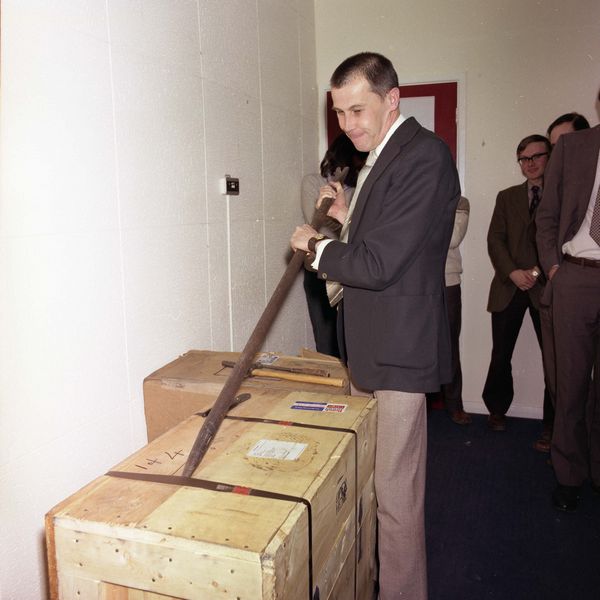
Having waited over a year for the machine already and given ICL's own interest in its arrival, opening the package was delayed two days to allow Charlie Portman's engineers to be involved in the initial testing.
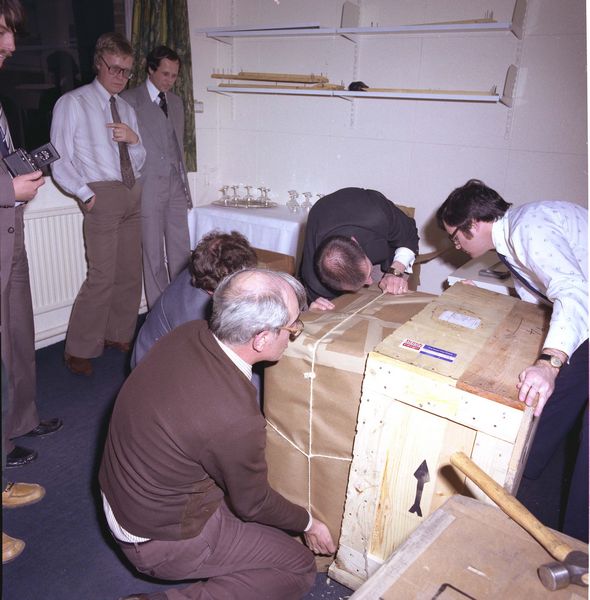
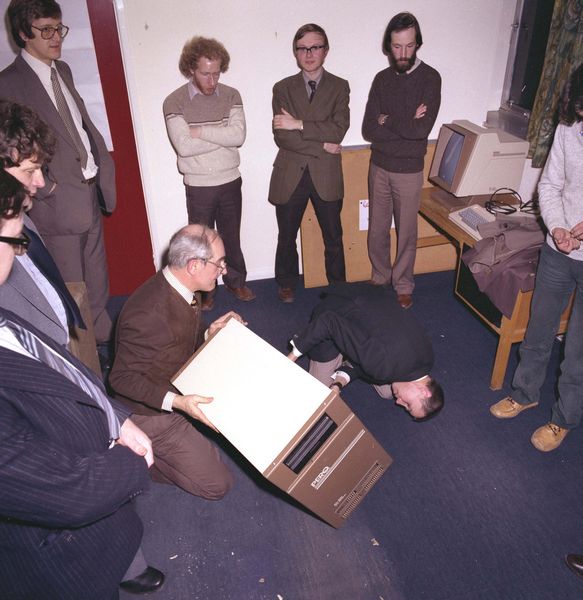
The year 1980 was a real anti-climax. A delivery of early in 1980 was eventually achieved a year late. Slippage was partly due to over optimistic estimates by Three Rivers, partly by the failure of sub contractors to deliver PCB masks, partly the need to produce an effective launch at SIGGRAPH and finally a loss of position in the queue due to pressure from companies such as Lucas Films and IBM who had money and muscle in larger amounts than SERC.
Finally, delivery was delayed by Christmas and the vagaries of the British Embassy in the USA.
Meanwhile, competition starts to appear from Apollo although the quality of the initial product is such that it is not a major threat to Three Rivers.